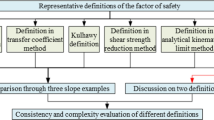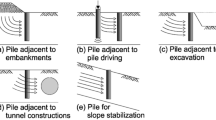Abstract
The stability of a large-scale cut slope subjected to staged reinforcement has been investigated using field monitoring and slope modeling. The slope reinforcements used include piling, nailing, and anchoring and these were installed in the upper and lower parts of the slope in six stages. To analyze changes in the stability of the reinforced slope during these stages, an instrumentation system was installed and monitored carefully. It was observed that the safety factor of the slope, and the deflection and bending stresses of the stabilizing piles varied significantly as the reinforcements work processed. The most critical stage was observed to occur during the soil-nailing stage. The measured deflection of piles at the pile head is smaller than that of the analytical values. The result comes from the influence of the restrained effect of horizontal deflection caused by both anchoring in the upper part and concrete capping in the lower part. The safety factor of the slope is gradually increased, subjected to reinforcement stages and satisfied with the allowable standard values in both dry and rainy conditions.

















Similar content being viewed by others
References
Abbot P (1996) Natural disasters, Brown, 438 pp
Asaoka A, Athanasiou-Grivas D (1981) Short-term reliability of slopes under static and seismic conditions. Transp Res Rec 809:64–70
Baker R (1980) Determination of the critical slip surface in slope stability computation. International J of Numerical and Analytical methods in Geomechanics 14:333–359
Bhattacharya G, Basudhar PK (2001) A new procedure for finding critical slip surfaces in slope stability analysis. Indian Geotech J 31(1):149–172
Chen WF, Giger MW (1971) Limit analysis of stability of slopes. J Soil Mech Found Div, ASCE 97(1):19–26
Coch NK (1995) Geohazards, natural and human. Prentice Hall, 481
Ellis W, Hartman VB (1967) Dynamic soil strength and slope stability. J Soil Mech Found Div, ASCE 93(4):355–375
Fang HY (1991) Foundation engineering handbook, Chapter 10: Stability of earth slopes. Reinhold, New York
Hong WP, Song YS (2006) Development of a computer program to analyze stability of slopes reinforced by the earth retention system. J Eng Geol, KSEG 16(1):45–58 (in Korean with English Abstract)
Huang YH (1983) Stability analysis of earth slope. Reinhold, New York
Ito T, Matsui T, Hong WP (1981) Design method for the stabilizing piles against landslide—one row of piles. Soils and Foundations 21(1):21–37
Ito T, Matsui T, Hong WP (1982) Extended design method for multi-row stabilizing piles against landslide. Soils and Foundations 22(1):1–13
Katz O, Aharonov E (2006) Landslides in a vibrating sand-box: what controls types of slope-failure and frequency magnitude relations? Earth Plant Sci Lett 247(3–4):280–294
Kim JH, Jeong SS, Park SW, Sharma J (2004) Influence of rainfall-induced wetting on the stability of slopes in weathered soils. J Eng Geol 75:251–262
Korea Metrological Administration (2002) National Institute Disaster Prevention: The study of causes and reduction countermeasures of slope failures according to types
Lo KY (1965) Stability of slopes in anisotropic soils. J Soil Mech Found Div, ASCE 93(4):1–33
Murck BW, Skinner BJ, Porter SC (1996) Dangerous earth: an introduction to geologic hazards. Wiley, New York
Seed HB (1967) Slope stability during earthquakes. J Soil Mech Found Div, ASCE 93(4):299–323
Song YS, Hong WP (2007) A case study on the analysis of cause and characteristics of a landslide at the sedimentary rock area. J Eng Geol, KSEG 17(1):101–113 (in Korean with English Abstract)
Spencer E (1968) Effect of tension on stability of embankments. J Soil Mech Found Div, ASCE 94(5):1159–1173
Wu TH (1984) Effect of vegetation on slope stability. Transp Res Rec 965:37–46
Zhang XJ, Chen WF (1987) Stability analysis of slopes with general nonlinear failure criterion. Int J Numer Anal Methods Geomech 11:33–50
Acknowledgments
This research was supported by the Basic Research Project (development of practical technologies for countermeasures for hazards in steep slope and abandoned mine area) of the Korea Institute of Geoscience and Mineral Resources (KIGAM) funded by the Ministry of Knowledge Economy of Korea.
Author information
Authors and Affiliations
Corresponding author
Rights and permissions
About this article
Cite this article
Kang, GC., Song, YS. & Kim, TH. Behavior and stability of a large-scale cut slope considering reinforcement stages. Landslides 6, 263–272 (2009). https://doi.org/10.1007/s10346-009-0164-5
Received:
Accepted:
Published:
Issue Date:
DOI: https://doi.org/10.1007/s10346-009-0164-5




